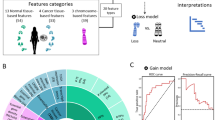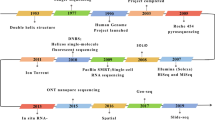Abstract
Background: In the last decade, microarray technology has been extensively used to evaluate gene expression profiles and genome imbalances. We have developed a microarray-based comparative genomic hybridization (CGH) approach to identify MYCN gene amplification and 1p36 chromosome loss, two markers of tumor aggressiveness in neuroblastoma.
Aim: The aim was to use microarray CGH technology to detect the two major prognostic markers for neuroblastoma, MYCN amplification and 1p36 chromosome deletion, in neuroblastoma patients and, therefore, confirm the usefulness of this approach in this cancer.
Methods: DNA was purified from 16 tumors containing at least 90% malignant neuroblasts and collected at the onset of disease. Pooled fluorescent-labeled reference and neuroblastoma tumor genomic DNA was hybridized to epoxide-coated glass slides on laboratory-made complementary DNA microarray. The microarray contained cDNA mapped at the 1p36.33–36.1 chromosomal region and MYCN gene. cDNA from the 2q33–q34 and 12p13 chromosomes was used as a control and Arabidopsis thaliana DNA was spotted to control unspecific hybridization. Fluorescence in situ hybridization analysis was also performed to validate results from the microarray CGH.
Results: Both MYCN amplification and 1p36 chromosome deletion were detected by microarray CGH. The sensitivity and specificity for 1p36 loss detection were 66.7% and 90.0%, respectively. The method had a sensitivity of 66.7% and specificity of 90.9% to detect MYCN amplification.
Discussion: Our results demonstrated that the microarray CGH can be efficiently applied to study DNA gain and loss of specific chromosome regions.




Similar content being viewed by others
References
Brodeur GM. Neuroblastoma: biological insights into a clinical enigma. Nat Rev Cancer 2003; 3: 203–16
Brodeur GM, Seeger RC, Schwab M, et al. Amplification of N-MYC in untreated human neuroblastomas correlates with advanced disease stage. Science 1984; 224: 1121–4
Seeger RC, Brodeur GM, Sather H, et al. Association of multiple copies of the N-myc oncogene with rapid progression of neuroblastomas. N Engl J Med 1985; 313: 1111–6
White PS, Maris JM, Beltinger C, et al. A region of consistent deletion in neuroblastoma maps within human chromosome 1p36.2–36.3. Proc Natl Acad Sci U S A 1995; 92: 5520–4
Caron H, van Sluis P, de Kraker J, et al. Allelic loss of chromosome 1p as a predictor of unfavorable outcome in patients with neuroblastoma. N Engl J Med 1996; 334: 225–30
Tonini GP, Boni L, Pession A, et al. MYCN oncogene amplification in neuroblastoma is associated with worse prognosis, except in stage 4s: the Italian experience with 295 children. J Clin Oncol 1997; 15: 85–93
Ambros IM, Benard J, Boavida M, et al. Quality assessment of genetic markers used for therapy stratification. J Clin Oncol 2003; 21: 2077–84
Veltman JA, Fridlyand J, Pejavar S, et al. Array-based comparative genomic hybridization for genome-wide screening of DNA copy number in bladder tumors. Cancer Res 2003; 63: 2872–80
Bruder CE, Hirvela C, Tapia-Paez I, et al. High resolution deletion analysis of constitutional DNA from neurofibromatosis type 2 (NF2) patients using microarray-CGH. Hum Mol Genet 2001; 10: 271–82
Hui AB, Lo KW, Yin XL, et al. Detection of multiple gene amplifications in glioblastoma multiforme using array-based comparative genomic hybridization. Lab Invest 2001; 81: 717–23
Takeo S, Arai H, Kusano N, et al. Examination of oncogene amplification by genomic DNA microarray in hepatocellular carcinomas: comparison with comparative genomic hybridization analysis. Cancer Genet Cytogenet 2001; 130: 127–32
Wilhelm M, Veltman JA, Olshen AB, et al. Array-based comparative genomic hybridization for the differential diagnosis of renal cell cancer. Cancer Res 2002; 62: 957–60
Clark J, Edwards S, John M, et al. Identification of amplified and expressed genes in breast cancer by comparative hybridization onto microarrays of randomly selected cDNA clones. Genes Chromosomes Cancer 2002; 34: 104–14
Seo MY, Rha SY, Yang SH, et al. The pattern of gene copy number changes in bilateral breast cancer surveyed by cDNA microarray-based comparative genomic hybridization. Int J Mol Med 2004; 13: 17–24
Arai H, Ueno T, Tangoku A, et al. Detection of amplified oncogenes by genome DNA microarrays in human primary esophageal squamous cell carcinoma: comparison with conventional comparative genomic hybridization analysis. Cancer Genet Cytogenet 2003; 146: 16–21
Clark J, Edwards S, Feber A, et al. Genome-wide screening for complete genetic loss in prostate cancer by comparative hybridization onto cDNA microarrays. Oncogene 2003; 22: 1247–52
Wessendorf S, Schwaenen C, Kohlhammer H, et al. Hidden gene amplifications in aggressive B-cell non-Hodgkin lymphomas detected by microarray-based comparative genomic hybridization. Oncogene 2003; 22: 1425–9
Squire JA, Pei J, Marrano P, et al. High-resolution mapping of amplifications and deletions in pediatric osteosarcoma by use of CGH analysis of cDNA microarrays. Genes Chromosomes Cancer 2003; 38: 215–25
Tong CY, Hui AB, Yin XL, et al. Detection of oncogene amplifications in medulloblastomas by comparative genomic hybridization and array-based comparative genomic hybridization. J Neurosurg 2004; 100: 187–93
Schwaenen C, Nessling M, Wessendorf S, et al. Automated array-based genomic profiling in chronic lymphocytic leukemia: development of a clinical tool and discovery of recurrent genomic alterations. Proc Natl Acad Sci U S A 2004; 101: 1039–44
Beheshti B, Braude I, Marrano P, et al. Chromosomal localization of DNA amplifications in neuroblastoma tumors using cDNA microarray comparative genomic hybridization. Neoplasia 2003; 5: 53–62
Ambros PF, Ambros IM, and the SIOP Europe Neuroblastoma Pathology, et al. Pathology and biology guidelines for resectable and unresectable neuroblastic tumors and bone marrow examination guidelines. Med Pediatr Oncol. 2001 Dec; 37(6): 492–504
Shimada H, Ambros IM, Dehner LP, et al. The international neuroblastoma pathology classification (the Shimada system). Cancer 1999; 86: 364–72
Sambrook J, Fritsch EF, Maniatis T. Molecular cloning: a laboratory manual. New York: Cold Spring Harbor Laboratory Press, 1989
I.M.A.G.E. Consortium [online]. Available from URL: http://image.llnl.gov/ [Accessed 2004 Jul 28]
NCBI UniGene [online]. Available from URL: http://www.ncbi.nlm.nih.gov/UniGene [Accessed 2004 July 20]
Lo Cunsolo C, Iolascon A, Cavazzana A, et al. Neuroblastoma in two siblings supports the role of 1p36 deletion in tumor development. Cancer Genet Cytogenet 1999; 109: 126–30
Peter M, Michon J, Vielh P, et al. PCR assay for chromosome 1p deletion in small neuroblastoma samples. Int J Cancer 1992; 52: 544–8
Schena M. Microarray analysis. New York: J Wiley & Sons Press, 2003
Nadon R, Shoemaker J. Statistical issues with microarrays: processing and analysis. Trends Genet 2002; 18: 265–71
Shoemaker DD, Linsley PS. Recent developments in DNA microarrays. Curr Opin Microbiol 2002; 5: 334–7
Ambros PF, Ambros IM, Kerbl R, et al. Intratumoural heterogeneity of 1p deletions and MYCN amplification in neuroblastomas. Med Pediatr Oncol 2001; 36: 1–4
Takeda O, Homma C, Maseki N, et al. There may be two tumor suppressor genes on chromosome arm 1p closely associated with biologically distinct subtypes of neuroblastoma. Genes Chromosomes Cancer 1994; 10: 30–9
Iolascon A, Lo Cunsolo C, Giordani L, et al. Interstitial and large chromosome 1p deletion occurs in localized and disseminated neuroblastomas and predicts an unfavorable outcome. Cancer Lett 1998; 130: 83–92
Solinas-Toldo S, Lampel S, Stilgenbauer S, et al. Matrix-based comparative genomic hybridization: biochips to screen for genomic imbalances. Genes Chromosomes Cancer 1997; 20: 399–407
Acknowledgements
This work was supported by the Fondazione Italiana per la Lotta al Neuroblastoma, Associazione Italiana per la Ricerca sul Cancro (AIRC), European Union 5th FP (QLRT-2001-02831 and QLRT-2001-02198) and the Ministero dell’Università e della Ricerca Scientifica e Tecnologica. We are grateful to the surgeons, clinicians, and pathologists of the Italian Cooperative Group for Neuroblastoma and to the Associazione Italiana di Ematologia e Oncologia Pediatrica for providing tumor samples.
Dr Scaruffi was partially supported by a Research Training Fellowship awarded by the International Agency for Research on Cancer. The authors have provided no information on conflicts of interest directly relevant to the content of this study.
Author information
Authors and Affiliations
Corresponding author
Rights and permissions
About this article
Cite this article
Scaruffi, P., Parodi, S., Mazzocco, K. et al. Detection of MYCN amplification and chromosome 1p36 loss in neuroblastoma by cDNA microarray comparative genomic hybridization. CNS Drugs 8, 93–100 (2004). https://doi.org/10.1007/BF03260051
Published:
Issue Date:
DOI: https://doi.org/10.1007/BF03260051




